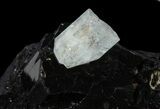This Specimen has been sold.
Aquamarine on Black Tourmaline - Erongo Mountains, Namibia
A lone, pale blue aquamarine crystal sits atop a lusterous, well-terminated chunk of schorl from the Erongo Mountains in Namibia. Although the schorl has broken away from the host rock, the crystal is in overall good shape, and displays nicely on a flat surface.
Beryl is a mineral composed of beryllium aluminum cyclosilicate, with the chemical formula Be3Al2(SiO3)6. Naturally occurring beryl tends to form hexagonal crystals that can reach several meters in size if given the right conditions. Completely pure beryl will be transparent and colorless, while mineral impurities frequently tint the crystals color in most specimens.
Well known varieties of beryl include aquamarine and emerald, although beryl can also be green, blue, yellow, white and red, depending on the incorporated impurities during formation. Red beryl is its rarest form, and can currently only be found in New Mexico and Utah.
Well known varieties of beryl include aquamarine and emerald, although beryl can also be green, blue, yellow, white and red, depending on the incorporated impurities during formation. Red beryl is its rarest form, and can currently only be found in New Mexico and Utah.
Schorl, also known as "black tourmaline" or "black schorl", is a black form of tourmaline that often occurs as lustrous prismatic crystals. The crystals can be stubby or elongated and typically feature lengthwise striations. Many schorl crystals have flattened pyramidal terminations. They can also form in radiating, columnar, and stalactitic aggregations, as well as small, needle-like inclusions within quartz (tourmalinated quartz) and in massive form.
Schorl is a basic sodium iron aluminum boro-silicate with the generic chemical formula NaFe2 + 3Al6(BO3)3Si6O18(OH)4 . It has been used for everything from jewelry to piezoelectric guitar pickups.
Schorl is a basic sodium iron aluminum boro-silicate with the generic chemical formula NaFe2 + 3Al6(BO3)3Si6O18(OH)4 . It has been used for everything from jewelry to piezoelectric guitar pickups.
SPECIES
Aquamarine, Tourmaline
LOCATION
Erongo Mountains, Namibia
SIZE
Aquamarine is .39x.25" on 2x1.59x1.29" Schorl
CATEGORY
SUB CATEGORY
ITEM
#31878
 Reviews
Reviews













